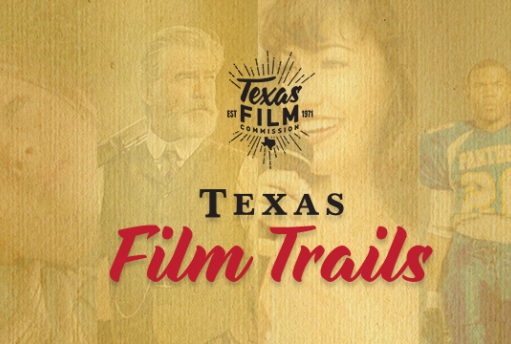2010s: Fostering the Creative Community

Thanks in large part to the omnipresence of the internet in the lives of 21st century individuals, the ever-shifting borderlines of digital media and the subsequent rise of the phenomenon known throughout the media production industries as convergence, it is by this point more difficult to draw a clear line of demarcation between the 2010s and the decade prior in terms of content created. Taking a sizable leap into the future of Texas’ creative workforce, the 2010s provided an opportunity for the creative community in Texas to evolve and embrace a modern approach to the business of storytelling and entertainment. If there is a theme that runs throughout Texas media production in the 2010s (hereafter referred to simply as "the ‘10s") it is this: over the past 50 years, no other decade has proved more succinctly that in spite of the fact that we are the Texas Film Commission, our office exists to serve a constituency of Texans that extends far beyond the bounds of feature film production alone.
While the TFC was created as part of the Office of the Governor all the way back in 1971, a significant event occurred during this decade when the agency was officially moved within the Office of the Governor’s Economic Development and Tourism Division. Much of our work, such as promoting Texas as a premier production destination (by this point not just for feature films,but the whole spectrum of media production) continued as usual, but with renewed emphasis on long-term business development for media production within the Lone Star State. As the Texas Film Commission evolved, so too did the benefits to the industries served by our office.

BTS Still from Support the Girls (2018) / © Magnolia Pictures
Feature films have always been a major part of the media production industries in Texas and would continue to be throughout this decade. The ‘10s saw a change in the types of projects that predominately came through the state, as more opportunities became available for both smaller-budgeted and marquee productions alike, as well as a wave of popular television productions (as we’ll see shortly). Though Texas may have produced fewer Armageddon-sized films than in previous decades, the absence of such blockbuster pictures proved to make space for the commanding talent coming out of Texas in this one. Because of the ecosystem of support the state can provide, thanks to Texas’ independent resolve and inherent self-sufficiency, as well as in large part to our highly skilled and long serving local crews, ample opportunity was provided for more personal, story-driven productions to operate comfortably and Texas filmmakers quickly stepped up to take advantage. Take for example Irving-native David Lowery, who, after making Ain’t Them Bodies Saints (2013), a romantic crime film steeped in Bonnie and Clyde-esque mythology, decamped to New Zealand to direct Disney’s Pete’s Dragon (2016), only to make his way back to Texas for A Ghost Story (2017), a hauntingly beautiful film set and shot in Dallas, about, among other things, the nature of love and the immensity of time.
Andrew Bujalski, another Texas-based filmmaker, would go on to be tapped by Disney to reboot a classic property for new audiences (this time the screenplay for 2019’s Lady and the Tramp), shot three films in the Austin area alone across the decade: Computer Chess (2013, featuring Dazed and Confused star Wiley Wiggins), Results (2015) and Support the Girls (2018), an entertaining and empathetic look at the women working day in and day out at a local sports bar, that was namechecked by former President Barack Obama as one of his favorite films of 2018.
The changing face of the media production industries in Texas showcased several talented female directors with career-shifting feature films. A good number of these filmmakers would springboard off the success of their Texas-made projects into bigger-budgeted, more widely seen works. After writing, directing and producing her feature debut, the Sundance Film Festival hit Never Goin’ Back (2018), Garland-native Augustine Frizzell moved on to direct the pilot of recent HBO megahit Euphoria. And Frizzell is not alone in this camp - one need look no further than to the career of Nia DaCosta, writer and director of the upcoming Candyman reboot for MGM, to see a similar story. Prior to landing that gig, she made her way down to Texas to helm her directorial debut Little Woods (2018), an intimate thriller that filmed in Austin, Taylor, Luling and Manor before premiering at the Tribeca Film Festival.
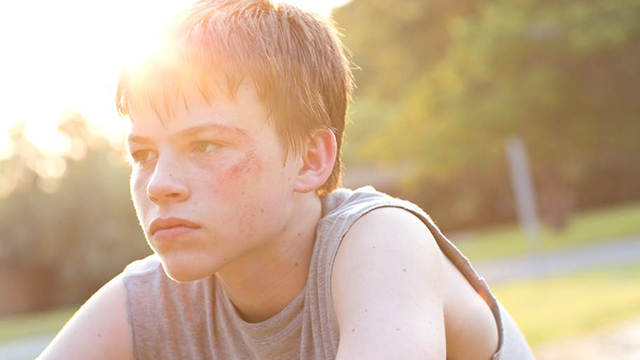
Still from Hellion (2014) / © Across Town Productions
Perhaps the best example of this phenomenon however is Kat Candler, a filmmaker with Texas roots that go as far back as the turn of the millennium, when she wrote, directed, produced and edited her first film Cicadas (2000) in Austin, Liberty Hill and Bertram. 14 years and several projects later, Candler would release Hellion (2014), the complicated tale of a troubled 13-year-old and the struggling, blue-collar family that surrounds him. Filmed in the East Texas enclaves of Port Neches, Groves, Port Arthur, Beaumont and Baytown, the film would go on to premiere in the US Dramatic Category at the 2014 Sundance Film Festival and earn a nomination for the Grand Jury Prize. Candler was able to capitalize on the success of Hellion and turn towards television production, a new avenue that would come to define the bulk of her career since her indie days in Texas. She would go on to be a Writer, Director and Producer on shows like OWN’s Queen Sugar and Netflix’s 13 Reasons Why, known as an indie darling with Texas ties making waves in the wider world of scripted, episodic television.
Texas has a long and storied history of producing popular, acclaimed television series (Friday Night Lights being perhaps the best known of these), and the ‘10s must be acknowledged as the decade where television truly carved out its niche in the Lone Star State. This is certainly not by accident either; as a byproduct of our long-standing ranking as the best state in the country for business, Texas is highly amenable to shouldering the weight of long-running television productions. From the lower cost of living (especially compared to other destination media production states) to the elevated quality of life in and around the handful of media hubs that have developed across the state over the past 50 years, Texas is uniquely suited to not just hosting, but fostering several television productions and throughout the decade did just that. Long-running television productions oftentimes offer a sense of stability to the cast, crew and local businesses, allowing them to work near their homes and establish roots in the areas where they find themselves stationed.

Still from Fixer Upper (2013-17) / © Rachel Whyte/HGTV
Arguably the most successful of a number of reality television series in the ‘10s, Chip and Joanna Gaines’ Fixer Upper (2013-2018) managed over the course of five seasons to not only produce a consistently popular show, but to help transform Waco into a bonafide tourist destination. This success laid the track for their upcoming Magnolia Network, a joint venture with Discovery Channel, set to launch in 2022. At the height of the series popularity, they helped to draw more than 30,000 visitors a week to their Magnolia Market, a business that continues to inject seismic amounts of tourism dollars into the local economy. Also a boon for Texas tourism: PBS’ The Daytripper (2009-present), hosted by former TFC intern Chet Garner. With a focus on “[inspiring] folks to get out and explore their own backyard,” Garner spends each episode diving deep into an individual city or town within Texas, highlighting the culture, cuisine, outdoor adventures, local businesses and idiosyncrasies that make up the varied regions of the state.
Also continuing production in this decade were programs like Dallas Cowboy Cheerleaders: Making the Team (2006-present), newer programs like Richard Rawlings’ Fast N Loud (2012-2020), and the El Rey Network’s Rebel Without a Crew (2018), which centered around the premise of shooting a feature film in only two weeks, with a budget of $7,000. But make no mistake, at any given point in time, scripted series also made up a large portion of the state’s production slate as well. 2015 would see HBO’s critically-acclaimed The Leftovers (2014-2017) roll across state lines and set up shop primarily in the Central Texas town of Lockhart, transforming it into the fictional ‘miracle’ town of Jarden, Texas (they would also utilize Bastrop, Johnson City, Del Valle, Spicewood and Uhland before the dust finally settled). At around the same time, the ABC anthology crime drama American Crime (2015-2017) was busy at work just miles down I-35, where Austin would stand in for Modesto, California. Over the course of two seasons, the series would also feature Georgetown, Bee Cave, Round Rock, Cedar Park, Coupland, Lakeway, Manor, Pflugerville, San Marcos and West Lake Hills. And any accounting of the period would be wholly remiss if it did not include Fear the Walking Dead (2015-present), the first, and to-date most successful, spinoff of AMC’s era-defining hit The Walking Dead. While the production of Fear did not arrive in Texas until its fourth season, it has certainly embraced the multitude of locales found within the Lone Star State, and dedicated fans flock each and every year to the myriad filming locations that pepper the Central Texas area, providing our agency the opportunity to expand the Texas Film Trails program. Season Four of Fear alone used enough locations for the TFC to create a Film Trail solely dedicated to the Texas communities, locations and businesses that welcomed the production.
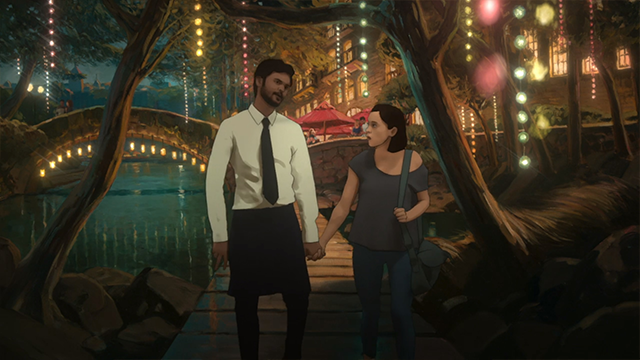
Still from Undone (2019) / © Minnow Mountain
Texas-based Minnow Mountain recreated San Antonio locales
(like the San Antonio River Walk, pictured here) by using rotoscope animation.
It goes without saying that animation was absolutely in equal standing alongside live-action productions. Both onscreen and behind the scenes, Texas animation studios worked to revolutionize not just the content they were producing, but the manner in which they would be producing it. Take for instance Austin’s own Powerhouse Animation, producers of such acclaimed works as Netflix’s Castlevania (2017-2021), Seis Manos (2019), and the upcoming Masters of the Universe: Revelations (2021), a direct sequel to the beloved 1983 series. Just this past year they helped to form the Women in Animation Austin chapter, and pledged to “support the careers of women in the city’s animation industry, and to increase their number, aiming for 50/50 parity by 2025.” Also participating in the effort to help establish the WIA Austin chapter was local digital media heavyweight Rooster Teeth; an Austin establishment to their very core, Rooster Teeth was significantly expanding their reach in the Texas animation scene specifically during the ‘10s. Their origin story as an organization began as a niche gaming community, but their meteoric rise over the course of a single decade has generated a global audience and dedicated fanbase across a variety of mediums.

BTS Still from gen:LOCK (2019) / © Rooster Teeth
Founded in 2003 by University of Texas at Austin alums, the company slowly but surely built a fanbase with Red vs. Blue, a web series primarily utilizing the machinima technique of synchronizing pre-recorded audio to footage captured, more often than not, from video games, in this case Halo: Combat Evolved (which, astute readers will remember, has its own Texas ties). The longest running web series of all time, Red vs. Blue would help Rooster Teeth establish the dedicated audience that would flock to their next project, RWBY (2013-present). Combining elements of Western animation and anime in what series creator Monty Oum referred to as “a two-dimensional, toon-shaded look, but with all of the depth and complexity of a 3D-animated production,” the look and feel of the series helped to establish the DNA for gen:LOCK (2019-present), an animated web series set in a dystopian future, starring Michael B. Jordan, Maisie Williams and others. For all of their myriad successes, Rooster Teeth has continued to both engage with and give back to the community that helped lift them to such heights through dedicated internship and training programs for the next generation of creators.
Looking back, it makes sense that those men and women who would go on to found Rooster Teeth would find themselves enamored with the idea of making videos innately tied to the video game world. They were, after all, in Texas, the third-largest state in the nation for video game development; considering that fact, it is not at all surprising that those filmmakers and creatives who were surrounded by video games throughout their formative years would seek to fuse the two worlds together. The video game development industry in Texas was already well established by the time Rooster Teeth opened their doors in 2003 and would only grow larger and more influential in the decade to follow. This was the decade of two of the biggest games in Texas video game history: BioWare Austin’s Star Wars: The Old Republic (2011-present; better known online as SWTOR) and Gearbox Software’s Borderlands series (2009-2019).
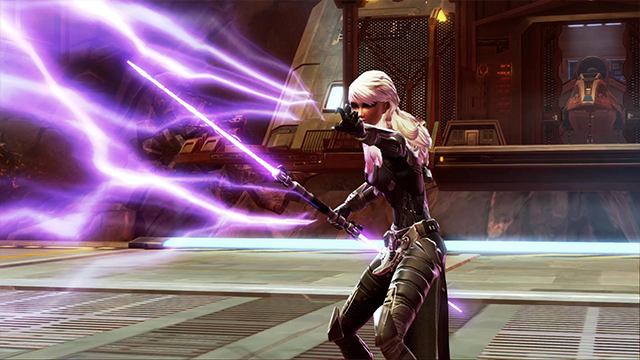
Still from Star Wars: The Old Republic (2011-present) / © BioWare
The fastest growing MMO (Massively Multiplayer Online game) ever at the time of its release, SWTOR garnered its first million players in just three days. Though the number of players engaging with the game has waxed and waned over the course of the decade since, it has remained consistently popular with fans of the Star Wars series and according to publisher Electronic Arts, by 2019 had brought in nearly a billion dollars in revenue, qualifying it as a massive success when compared to the project’s initial $200 million development budget.5 At the same time, up the road in Frisco, Texas, Gearbox Software’s Borderlands series was busy racking up successes of its own. Much like SWTOR, the Borderlands series stands as one of the best-selling video game franchises of all time, with net revenues of over a billion dollars as well. And the success of each game has not been limited to simply the financial side of things either – both companies have been critically lauded for their projects, with Borderlands 2 (2012) receiving Game of the Year nominations from several different gaming publications and SWTOR receiving Game Spy’s Best MMO award during their 2011 Game of the Year Awards. In addition, in 2012 SWTOR was awarded the AbleGamers Foundation's Mainstream Game for 2011 award, in recognition of its ability to accommodate players of special needs. In this way, BioWare gave back to the gaming community which had long supported them, aiming to provide a more inclusive space for gamers across all walks of life.
The idea of giving back—as the title of this very editorial implies ‘fostering the creative communities’—would prove a recurring theme throughout the decade and not just as it relates to the efforts of the Texas Film Commission. Already we have referenced several examples of creatives, be they individuals or organizations, fostering the development of their own communities, the ones they both work and live within, the places where they plant roots and eventually reap the fruits of their efforts. Another good example of this is College Station-based Triseum, a video game development studio focused on projects that promote Game-Based Learning (GBL), which they claim, “helps students achieve measurable educational goals like developing critical thinking skills or knowledge mastery of a subject.” Between games like Variant: Limits (2016), which is designed to help students understand and master abstract mathematical concepts, and helping to maintain an educator-focused community by providing game implementation guides for participating classrooms and research results on the positive impacts of their games, Triseum continues to demonstrate a commitment to improving the world through which they move. A study conducted by the company in collaboration with the nearby Texas A&M University showed a correlation between students who spent time playing Variant: Limits and higher exam scores.
Another company working in a similar vein is AMP Creative, a creative agency based in Dallas that, while founded primarily as a video production company, has expanded their portfolio and “evolved into a creative firm that creates engaging, effective learning.” They have since dedicated considerable time and effort to the idea that the two nascent technologies of Augmented and Virtual Reality (AR/VR) can be used to develop innovative learning strategies which can not only help to build a more respectful, effective workplace, but can help to prepare the trainees to be catalysts for change. In addition to all of this, they’ve never abandoned their initial charge and still operate AMP Studios, a one-stop video production studio offering clients a 10,000 square foot film and photography studio complex, as well as equipment rental and experienced, established local crew. They are but another prime example not only of the convergence of industries currently taking place in Texas, but of the way our local companies have invested in bettering the communities that continue to support them.
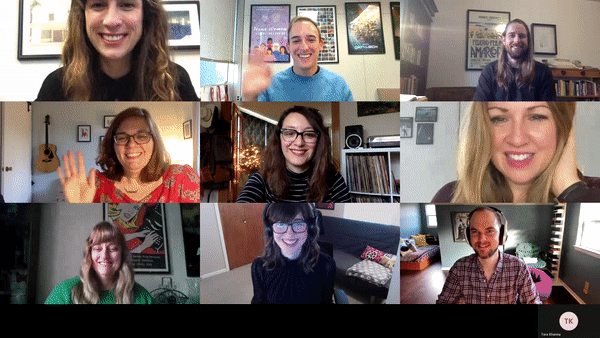
Thus is the (much abbreviated) tale of the Texas Film Commission and the Texas moving image industries over the course of the past fifty years. There were, of course, untold scores of projects, individuals and occurrences that did not make it onto the pages of these editorials; let that stand as a testament to the sheer number of moving pieces operating across the Lone Star State at any given point in time during these increasingly busy five decades. Now it is our duty to turn our attentions away from the past and to focus on the future, toward those individuals, businesses and projects that will come to define the next half-century of Texas Film Commission history.
We look with eager anticipation to a future where we are more fully equipped to support our media production industries than ever before, thanks to the tireless efforts expended over the past fifty years by all those who have passed through our office. We look forward to continued encouragement of increased business development in towns both big and small across the state, and to helping create jobs for the creative professionals in the years ahead. As the lines between film, television, animation, video games, XR and more continue to converge, we at the Texas Film Commission cannot wait to see what our incomparable Texas creatives, be they filmmakers, developers, actors, writers, coders, editors, testers or anything else, come up with next. The future shall be big and bright in Texas, so long as we continue to support those who help to make it so; so long as we continue to foster our creative communities and tend to the soil that yields the fruits of our efforts. It was John Steinbeck, all the way back in 1962, who said, “Rich, poor, Panhandle, Gulf, city, country, Texas is the obsession, the proper study, and the passionate possession of all Texans.” We tend to believe that to be the truth and we’re honored and humbled to have been granted fifty years to help cultivate, develop and safeguard even a portion of that possession.
Here’s to the next fifty.
Written and edited by Steven McCaig, Michelle Habecker, Taylor Hertsenberg and Stephanie Whallon.
Tour the Texas Film Trails
Created in 2016, the Trails provide you with a way to explore our history through self-guided tours of the Texas locations seen in our most iconic productions.
Economic Impact of Media Production
View the profound impact across the state of the Texas Moving Image Industry Incentive Program (TMIIIP).
Small Business Owners in Texas
View the available resources for small business owners in Texas including information about Local, State and Federal incentives, funding programs, small business forums and more.

